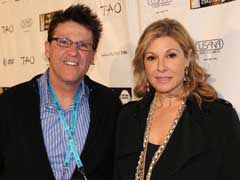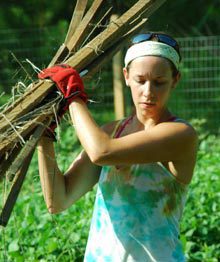(Editor’s note: the following originally appeared in two parts in Oct 2008)
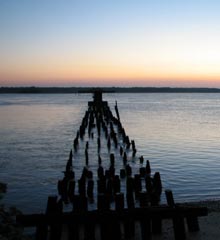 The earthworks of the abandoned railroad trestle split the marsh for more than a mile before ending abruptly in the dark tidal currents of the Broad River. The tracks are long gone. A rough washboard road remains flanked by scrub and brush and volunteer oaks tall and thick enough to form brief canopies. The trestle itself, or what’s left of it, looks like the victim of an air strike, whole sections missing, toothsome pylons jutting up out of the black water all askew.
The earthworks of the abandoned railroad trestle split the marsh for more than a mile before ending abruptly in the dark tidal currents of the Broad River. The tracks are long gone. A rough washboard road remains flanked by scrub and brush and volunteer oaks tall and thick enough to form brief canopies. The trestle itself, or what’s left of it, looks like the victim of an air strike, whole sections missing, toothsome pylons jutting up out of the black water all askew.
“We’d better get in the water.”
A soft breeze blows in, cooler than it has been, almost chilly. We pull the kayaks off of Judy’s pickup, snap paddles together, clip on life jackets.
“Watch where you step,” she warns, “it’s a little tricky.”
Somehow I make it down to the oyster shell beach toting my end of the boat without exhibiting any  hint of my usual cat-like dexterity. In the gray half-light I get the distinct impression that the beach is moving. A carpet of tiny crabs flee before us over shell and drifts of cordgrass in a unified sideways scuttle. They make a sound like rain drops on palm fronds as they fade into the marsh.
hint of my usual cat-like dexterity. In the gray half-light I get the distinct impression that the beach is moving. A carpet of tiny crabs flee before us over shell and drifts of cordgrass in a unified sideways scuttle. They make a sound like rain drops on palm fronds as they fade into the marsh.
We climb into the boats and paddle out into the wind and soft chop of the rising river, the first lipstick smear of sunrise silhouettes the ruined trestle. I back paddle for a better view, turning the bow into the current, port side east, starboard to the west. The sepia moon fades behind the key as the sun appears on the opposite horizon in a searing crimson arc. A dolphin breaks the surface just yards off my bow, spouts and briefly eyes us as if to say “tourists” before slipping back beneath the surface.
For an instant – a deeply, nearly indescribably sensual moment – we are suspended between night and day, literally floating between sun and moon, inundated with the perfume of sweet grass and salt air. There is no man-made noise – no sirens, no cars, no lawn equipment or power tools – only the sound of water, the wind on the river and the shore birds heralding the fresh morning. This is a perfect moment, like a June snowstorm in Yellowstone or a fall sunset on the Oregon coast – sunrise at Palm Key.
Art and Symbiosis
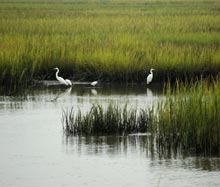 Judy Rigg sums up Palm Key in two words, “good energy.” Judy and her husband, Emil, stumbled upon the 350-acre island as newly retired residents of Hilton Head back in the early 1980’s. After years in the D.C. rat race (where Emil spent 3 decades at the National Institutes of Health) they were pondering the future with friends when the question of “what to do with the rest of our lives came up.”
Judy Rigg sums up Palm Key in two words, “good energy.” Judy and her husband, Emil, stumbled upon the 350-acre island as newly retired residents of Hilton Head back in the early 1980’s. After years in the D.C. rat race (where Emil spent 3 decades at the National Institutes of Health) they were pondering the future with friends when the question of “what to do with the rest of our lives came up.”
Disillusioned with what was happening to Hilton Head, the Riggs knew they wanted to create something that didn’t exist in the Lowcountry: a place where people could experience nature, explore, discover, heal and create.
“So, we made a list of things we wanted,” says Judy, “and we wanted a marsh island and we wanted to be able to get to fresh water, we wanted a road to it, and blah, blah, blah – just talking. And this woman came up behind us – she was catering the dinner – and says ‘my ex-husband has an option on a piece of land just like you’re talking about…’ And this is it!”
More than two decades later Palm Key is an eco-friendly colony of modern cottages and meeting facilities clustered among moss-covered oaks, surrounded by hundreds of acres of salt marsh and 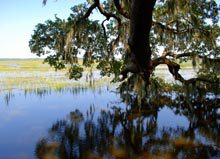 wildlife. Hundreds of heron, egrets and ibis nest in a nearby rookery. Eagles and hawks prowl the river. Raccoons stroll the grounds at twilight. This is a “green” retreat for individuals, families and groups “just five minutes off I-95,” laughs Judy, mimicking her famous public radio ad. Palm Key is also something of a grand experiment in symbiosis. While most of the cottages are individually owned, most are also available for rent and only a few have televisions or phones. A Property Owners Association and Board of Directors hold the enclave to the highest environmental standards, and higher standards are always being sought.
wildlife. Hundreds of heron, egrets and ibis nest in a nearby rookery. Eagles and hawks prowl the river. Raccoons stroll the grounds at twilight. This is a “green” retreat for individuals, families and groups “just five minutes off I-95,” laughs Judy, mimicking her famous public radio ad. Palm Key is also something of a grand experiment in symbiosis. While most of the cottages are individually owned, most are also available for rent and only a few have televisions or phones. A Property Owners Association and Board of Directors hold the enclave to the highest environmental standards, and higher standards are always being sought.
“Development is death,” says Judy. “This is about giving something back – creating energy rather than consuming it.”
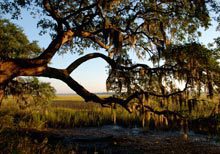 Judy’s brother, Ron Toole, is hosting an Elderhostel event of his own invention, “Barbecuing in the Lowcountry.” The average size of these groups runs about a dozen. Twenty eight people, mostly retired couples, have flocked to Palm Key from as far away as Seattle for five days of what I refer to as ‘Cue U. This essentially means the preparation, slow cooking and consumption of mass quantities of meat day after day after day. Another group is here to study meditation. Most, if not all of them, are vegetarian. Serenity abides, nonetheless.
Judy’s brother, Ron Toole, is hosting an Elderhostel event of his own invention, “Barbecuing in the Lowcountry.” The average size of these groups runs about a dozen. Twenty eight people, mostly retired couples, have flocked to Palm Key from as far away as Seattle for five days of what I refer to as ‘Cue U. This essentially means the preparation, slow cooking and consumption of mass quantities of meat day after day after day. Another group is here to study meditation. Most, if not all of them, are vegetarian. Serenity abides, nonetheless.
Ron bought the first cottage (number 31) back in 1989. He’s been a devotee since the beginning, echoing Judy’s thoughts. “It does seem to ignite peoples’ creative juices,” he says. “There’s a peace and serenity to it. No TV. No Phones. [Some] People have to get used to it but once they do they enjoy it.”
Kathie Torgison is out from Seattle with a friend. She’s just retired after thirty years flying around the world as an instructor for a major airline. “Why Palm Key? Why the Lowcountry? And why barbecue?” I ask. She shrugs, “Why not? I spent thirty years learning all about other cultures all over the world. Now I want to learn about the cultures in my own country.” And the ‘cue?’ “It’s something I didn’t know how to do and wanted to learn,” she smiles, “so why not come to where they know how to do it and learn from the best?”
Why not indeed?
The non-profit Institute at Palm Key is just part of the Rigg’s dream fulfilled. The Institute is  education-based with curricula rooted in “the unique ecology, art and history” of coastal South Carolina. The IPK’s nature programs include everything from professionally guided marsh and river tours to bird watching expeditions, dolphin spotting and some of the best fishing in the ACE basin. Corporate and group retreats are mainstays at the Institute, and wellness – of both body and mind – is a mission. A Palm Key Wellness Center is in the early stages of planning. And Judy’s quite proud of the Boys and Girls Club Art Program. Forty youngsters from nearby Ridgeland attend classes at the Institute twice a week, studying painting, photography and pottery. During the annual Art on the Porches the students become teachers as they assist with the art activities geared for kids.
education-based with curricula rooted in “the unique ecology, art and history” of coastal South Carolina. The IPK’s nature programs include everything from professionally guided marsh and river tours to bird watching expeditions, dolphin spotting and some of the best fishing in the ACE basin. Corporate and group retreats are mainstays at the Institute, and wellness – of both body and mind – is a mission. A Palm Key Wellness Center is in the early stages of planning. And Judy’s quite proud of the Boys and Girls Club Art Program. Forty youngsters from nearby Ridgeland attend classes at the Institute twice a week, studying painting, photography and pottery. During the annual Art on the Porches the students become teachers as they assist with the art activities geared for kids.
“It’s all about providing a sense of place,” says Judy.
Adrift Among the Metaphors
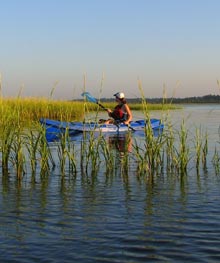 Back on the water we glide through the winding tidal creeks as the full moon tide reaches its zenith. The sun is up now, white and bright, blasting away any notion of a breeze, any whisper of fall’s approach. Judy’s paddled back to the truck. Her friend, Sheila, guides us through the labyrinthine waterways. We’re both former desert rats – Vegas residents – although my time there was but a blink compared to hers. I make the lame observation that this is as far from the Vegas experience as one can get. I am nothing if not a master of the obvious.
Back on the water we glide through the winding tidal creeks as the full moon tide reaches its zenith. The sun is up now, white and bright, blasting away any notion of a breeze, any whisper of fall’s approach. Judy’s paddled back to the truck. Her friend, Sheila, guides us through the labyrinthine waterways. We’re both former desert rats – Vegas residents – although my time there was but a blink compared to hers. I make the lame observation that this is as far from the Vegas experience as one can get. I am nothing if not a master of the obvious.
The marsh is awake now, and most of it is hungry. Tiny silver baitfish burst from the water like explosions of silver coins, fleeing the ubiquitous bigger fish. The metaphor is not lost. Spottail bass smack the surface with the force of a fourth grader’s cannonball at the county pool. Something that looks suspiciously like a small shark corners its unseen prey against a mat of grass, half out of the water for a split second, a crescent dorsal fin, the sleek brown body, an eruption of spray, then froth on the water and stillness. Another metaphor within a widening circle of rings. Majestic Snowy egrets fishing the creek edges rise at our approach. The big white birds are luminous against the shimmering green grasses and the sparkle of sun on the water. They croak and chortle their annoyance as they fly away looking back at us, cursing like old men at a secret honey hole. We round another bend and the process repeats itself. During this paddle we seem to annoy a huge segment of the indigenous population of Egretta Thula .
I hang back a bit to fumble with the camera. Sheila and my wife, Susan, float by, Sheila in her cherry 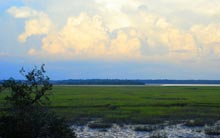 red kayak, Susan in bright blue. Their faces are serene, contemplative. Susan dangles her feet in the water, smiling. A flock of red-winged blackbirds cling to the stalks of cordgrass like hand-drawn notes on a sheet of music.
red kayak, Susan in bright blue. Their faces are serene, contemplative. Susan dangles her feet in the water, smiling. A flock of red-winged blackbirds cling to the stalks of cordgrass like hand-drawn notes on a sheet of music.
After a few futile attempts to capture the previous impression I give up on the camera. Someone once said “there comes a time to put away the camera before you miss what you’re shooting.” I believe it was my wife. Besides, the next few days here at Palm Key should offer ample opportunity to indulge my inner shutterbug.
I paddle my lime sherbet craft to join the others. We drift for a while in the stillness, listening, watching, smelling – senses fully engaged, moving at the whim of wind and water.
The Moon and Mrs. Parker
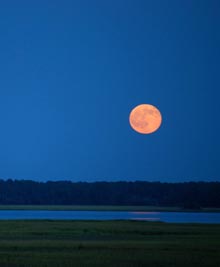 The day had been hot. The kind of hot that inspired the creation of air conditioning, modern refrigeration, the inflatable kiddie pool and any number of Tennessee Williams plays. This was the stifling, claustrophobic simmer worthy of Blanche DuBois. Oddly enough it calls up Neil Simon. As his autobiographical alter ego disembarks a World War II troop train in Biloxi Blues, Eugene Morris Jerome of Brooklyn proclaims “Man it’s hot. It’s like Africa hot. Tarzan couldn’t take this kind of hot.”
The day had been hot. The kind of hot that inspired the creation of air conditioning, modern refrigeration, the inflatable kiddie pool and any number of Tennessee Williams plays. This was the stifling, claustrophobic simmer worthy of Blanche DuBois. Oddly enough it calls up Neil Simon. As his autobiographical alter ego disembarks a World War II troop train in Biloxi Blues, Eugene Morris Jerome of Brooklyn proclaims “Man it’s hot. It’s like Africa hot. Tarzan couldn’t take this kind of hot.”
Indeed, we’re a mile from the sun – for now. Fall is out there. The signs are unavoidable, even to such a reluctant guest as summer. I can smell it. This morning it was practically palpable as we paddled out into the freshening tide of the Broad River, moonset to starboard, sunrise to port, a sweet breeze fleeing the onset of the day.
Now, it is the moon’s turn. Why is it, I wonder, that so many cultures attach the masculine to the sun and the feminine to the moon? How is it that the sun comes to symbolize war, aggression and power while Sister Moon inspires the sensual? The second story porch of cottage forty-four is the perfect place to ponder such things between the turn of a simple, eternal celestial routine.
An iridescent glow builds beyond the Broad, a pale backlight silhouettes the savannah and the furls of Spanish moss dripping from the gnarled oaks, limp and still as sorrow. All is calm. The moon arrives like Dorothy Parker at the Algonquin Round Table, suddenly outshining everything else in sight, dazzling in her pallid brilliance. She rises quickly clad in buttery yellow, the perfect match for a deep, ironic indigo sky and the shimmering train she trails across the water. This must be that “sense of place” I’ve heard so much about.
Get more on Palm Key at www.palmkey.com or phone 843-726-6524. Mark Shaffer’s email is backyardtourist@gmail.com.

